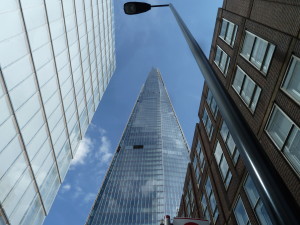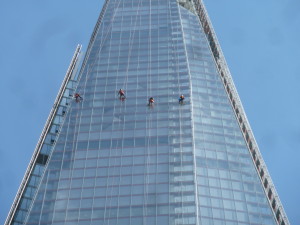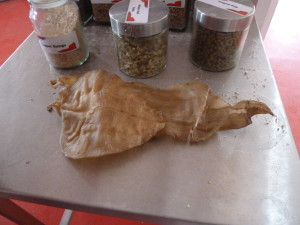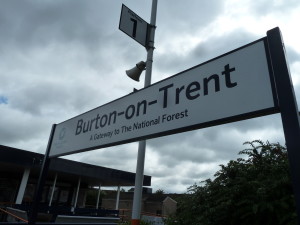 Arriving in Burton-On-Trent by train, you get a real sense of what William Blake must have meant by “dark satanic mills.” The landscape is one of rolling hills interspersed with small lakes and marshes until you’re suddenly confronted by the expansive brick warehouses and towering breweries that were the pride of the town’s industry in the 18th and 19th centuries. That they should spring suddenly upon you is surprising, as Burton-On-Trent is not as large as its reputation. At one time they would have expelled great quantities of smoke and steam into the sky, and on a cloudy day it would have seemed like they would choke the world.
Arriving in Burton-On-Trent by train, you get a real sense of what William Blake must have meant by “dark satanic mills.” The landscape is one of rolling hills interspersed with small lakes and marshes until you’re suddenly confronted by the expansive brick warehouses and towering breweries that were the pride of the town’s industry in the 18th and 19th centuries. That they should spring suddenly upon you is surprising, as Burton-On-Trent is not as large as its reputation. At one time they would have expelled great quantities of smoke and steam into the sky, and on a cloudy day it would have seemed like they would choke the world.
Having spent several days in London, walking a great deal more than I am used to, I had developed a habit of taking in detail. The two story row houses that make up the side streets stretched into the distance on the way to Marston’s. This was a company town with housing designed for workers, with facilities to meet their needs. The breweries sometimes provided cottages for their workers’ physical needs and churches to provide for their spiritual redemption. Red brick pubs like the Wellington Arms seem to have been stood there forever, waiting for the factory whistle or for the church to let out.
On the way down Shobnall Road from the train station, you cross over the Trent and Mersey canal. Now full of holidaymakers with damp socks, the canals would have once served as the main artery for distribution of beer throughout England. There was a period when Burton produced nearly a quarter of the country’s ale. In 1880, there were 30 breweries at work, although that number has since shrunk significantly.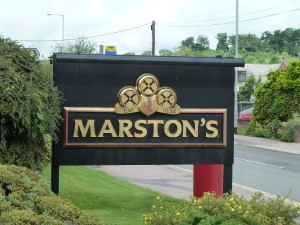
Currently, Burton houses eight breweries. Of these, six are micros. Bass has been taken over by Molson Coors. This means that of all of the breweries that at one time made Burton On Trent the brewing capital of England, only one remains under its original name at its original facitilies: Marston’s. This is not to say that Marston’s survived independently since its advent in 1834. It became part of Wolverhampton and Dudley Breweries in 1999, losing its name in the shuffle. After an eight year period, that group became Marston’s PLC, possibly out of a sense that heritage of that length is not something you want to obscure.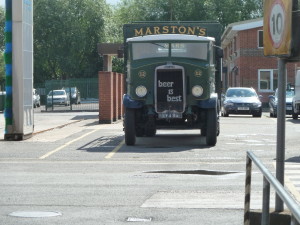
Crossing the yard to the visitor’s centre, you’re struck by the cumulative effect that such long history visually creates. Buildings and equipment of various eras and vintages dot the brewery compound. There stand Victorian row houses. There waits a delivery truck from an era before container shipping, now rejuvenated for display at beer festivals. To one side of the towering brewery are sheds sided with corrugated metal that would not be out of place in any industrial park. The air outside the brewery is filled with the sweet cereal aroma that only a really large brewery can produce in sufficient quantity to be suffusive. It escapes from the roof in wisps of steam.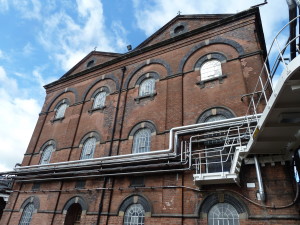
The sense of continuity that is on display is all of the legacy that can be expected, as Marston’s is not some museum showpiece. It would be folly to expect to see what it would have been like in the 1830’s. Over the years, the upgrades that have taken place to modernize the brewery and render it continually workable have stripped out much of what would have been there originally. It imparts the sense that a brewer’s day to day life as it was then might now be unknowable. However, if you pay attention, you can see how that routine must have changed as improvements were made.
It helps that the tour guide, Meryl, has been with the company for a considerable period. In a context like brewing, written documentation may well be less useful than institutional memory.
The tour progresses along catwalks and gangways, covering the topics that such tours always cover. Grain and hops, boilers and mash tuns. If you’re like I am and you have an understanding of how beer is made, that part of the tour is something that you would inevitably tune out. The building is the fascinating part; the scale of it is unlike a modern brewery. It’s a space on a human scale.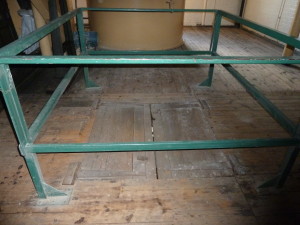
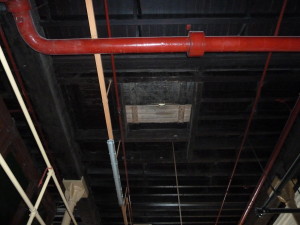
Meryl mentioned in passing that the trapdoors in the floor and ceiling were the method by which, when she started at the brewery, a man named Morris worked to hoist grain to the top of the mills by a system of pulleys. At this point in history, we might use augurs in lengthy PVC tubes to do that work. We might automate it completely. Not so very long ago, this would have been work done by a man with a system of pulleys and a set of trapdoors. If James Watt suggested that a pony could lift 220 pounds a hundred feet per minute on his way to a definition of horsepower, you can only imagine how many thousands of units of horsepower Morris expended over the course of his career.
You get the sense that Morris was a big lad who would have brooked little nonsense. He would have been glad of his pint at the end of a shift.
I was interested, over the course of the tour, to learn that Marston’s now brews with Reverse Osmosis water. That is water from which all the minerals have been stripped. It’s something of an irony that the process of adding gypsum to water for brewing, eponymously Burtonization, should be practiced in Marston’s. This is necessary, though, as the Marston’s brewery now produces a number of other brands which would have had their genesis in other parts of the country. Marston’s PLC produces Hobgoblin, which is one of their most popular beers and which is made primarily at the Burton brewery. There is a very real chance that the batch of Hobgoblin I saw made could end up at my local pub in Toronto at some point in early October.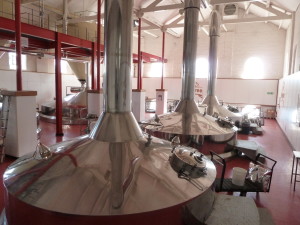
The original equipment was made of copper. Indeed, when Michael Jackson wrote about Marston’s in 1992, many of the fittings in use were still copper. The brewhouse is now gleaming stainless steel and glass. I took a moment away from the tour to speak with the brewer and asked what he thought about working in such a distinguished building. “It’s a listed building,” he said. “Can’t do a thing about insulation. It gets pretty cold in the winter.” It’s always pleasing to be reminded that brewers the world over are the same; getting on with a job that consumes both time and attention while still being niggled at by the limitations of their space.
Marston’s is now the only brewery left that produces beer on a large scale using the Burton Union system. The warehouses that hold their fermentation tanks are arranged around this endeavor, with large rectangular vessels taking up the outside walls that ring the Burton Union barrels on the production floor. The idea behind the Burton Union system is that fermentation takes place in a barrel and as the yeast vigorously propagates, the krausen (in this specific instance known as barm) pushes up through a pipe and into a long stainless steel trough that collects it. This is an idiosyncratic process and it’s easy to see why other breweries have shied away from it over the years. It would be time consuming. It would be difficult to maintain such a large amount of equipment. Anyone working the brewery would require time to adjust to the process and develop that specialized feel that comes with manipulating such a finicky set of variables. 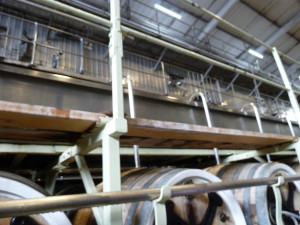
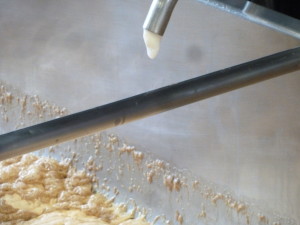
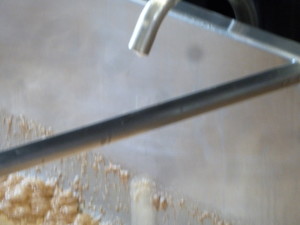
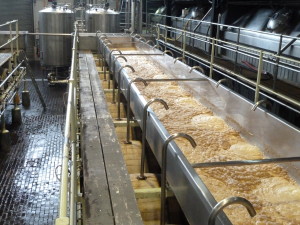
As we made our way along the catwalks and observed the pipes disgorging their barm into the trough, I was pleased to see that there was one such employee hurriedly making adjustments to the barrels below us. He would rap upon the top of each barrel with a wrench in order to determine the rate at which they were emptying. The batch that was fermenting at the time was ready for the next part of the process and without a visual cue, this percussive method would demonstrate whether the barrels were emptying. Being nominally a brewer myself and used to stainless steel and standard methods of fermenting beer, this seemed like a hell of a lot of effort. When I was younger, I would have opined that there’s something characteristically British about accomplishing a simple thing through what seems like an intentionally overcomplicated system. That may well be the case, but I know that this is also a characteristic of brewers.
The result is Marston’s Pedigree, which doesn’t taste quite like anything else. There is that slight sulphurous note that I’m told is the Burton Snatch. It’s a little like that tang from a match that has just been struck. There’s also the dried apple body. There’s tannin and caramel and something not quite but almost entirely unlike tea. There’s something a little like the papery internal structure of a freshly cracked walnut. You might be able to reach the same destination some other way, but some things shouldn’t be modernized.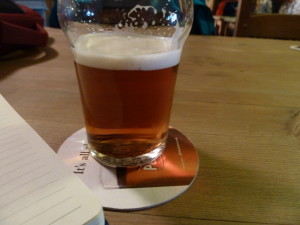
As I returned to London, I realized that one of the things that a brewery like Marston’s represents is that good beer is always about the people that produced it. There are some jobs that should not, can not be automated. It may seem a triviality to replace Morris with an augur or to replace a wrench wielding cellarman with a volume gauge, but I’m almost certain that the results would be different. That they would be worse.
It was heartening, emerging at London Bridge Station, to observe that even in 2013 with glass and steel monstrosities popping up over the City, even in an era where architectural futurism is practically the norm, there are some jobs that cannot be satisfactorily automated. 